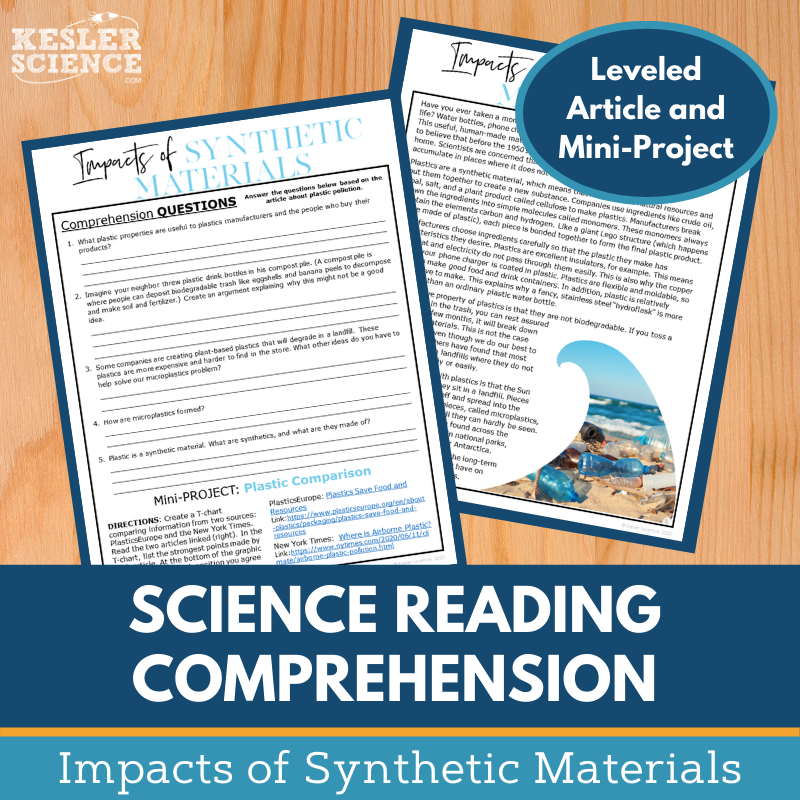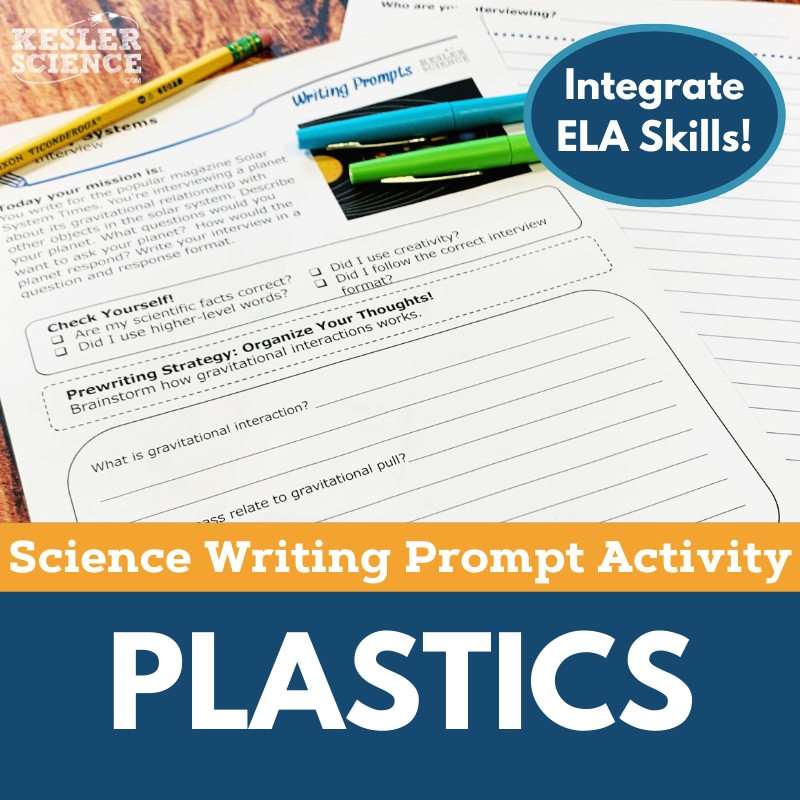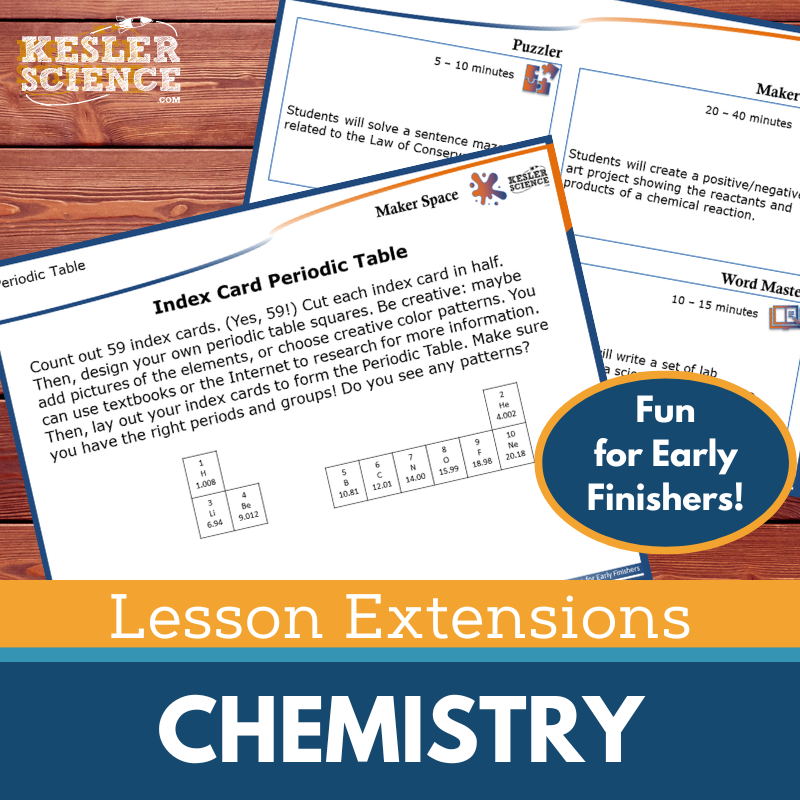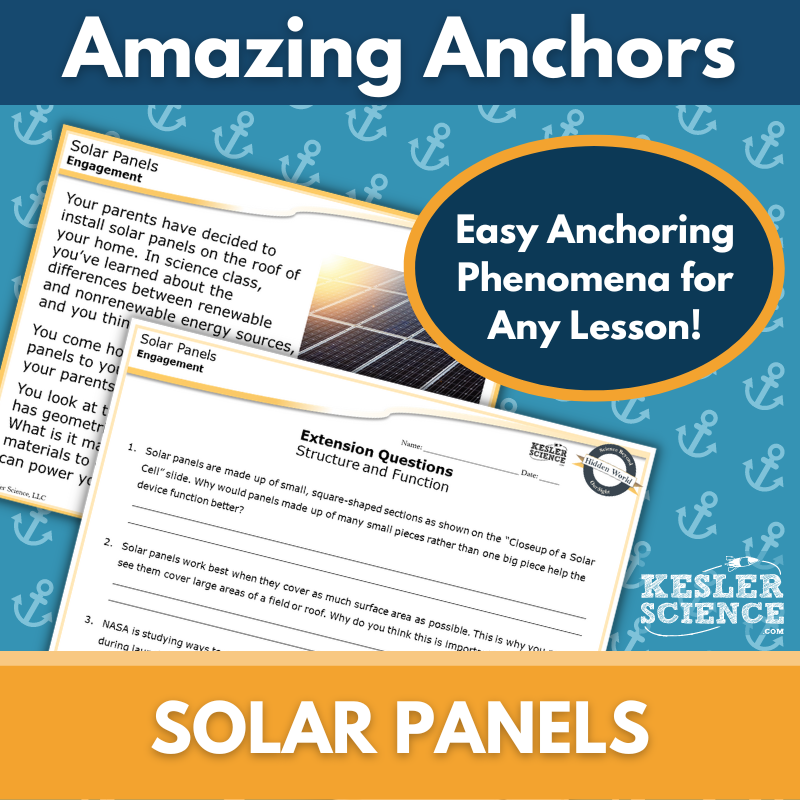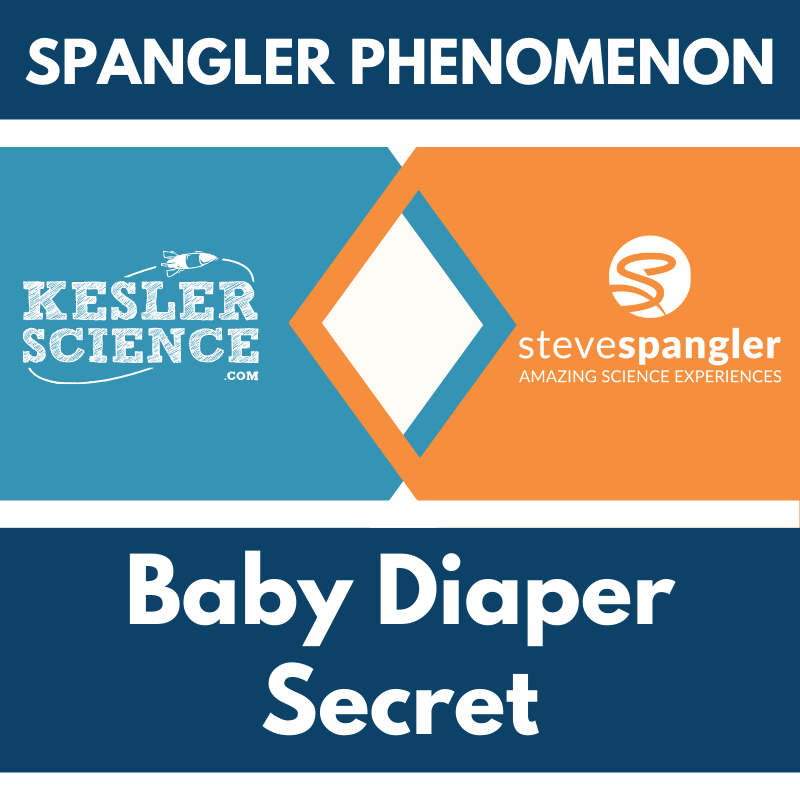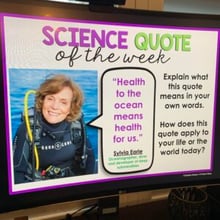Synthetic Materials Activities for Middle School Science
Aligned with NGSS MS-PS1-3, this comprehensive set of lessons immerses students in the exploration of synthetic materials, their origins from natural resources, and their societal impact. The resources below will give students a comprehensive understanding of synthetic materials. All of the following materials are also included in the Kesler Science Membership.
The Synthetic Materials Inquiry Lab aligns with NGSS MS-PS1-3, guiding students to explore the way synthetic materials are derived from natural resources and their impact on society. Students will engage in either a hands-on printed experiment or a virtual interactive lab, both featuring comprehension questions, Claim-Evidence-Reasoning (C.E.R.) prompts, and a reflection section.
The lab includes three differentiated versions—dependent, modified, and independent—to support all learners. In the hands-on version, students mix sodium alginate, calcium chloride, and distilled water to create a synthetic material, while the digital version features a pre-recorded demonstration for virtual engagement. Editable PowerPoints, answer keys, and teacher resource pages ensure flexibility for classroom use, with materials available in both print and digital formats.
The Synthetic Materials Inquiry Lab aligns with NGSS MS-PS1-3, guiding students to explore the way synthetic materials are derived from natural resources and their impact on society. Students will engage in either a hands-on printed experiment or a virtual interactive lab, both featuring comprehension questions, Claim-Evidence-Reasoning (C.E.R.) prompts, and a reflection section.
The lab includes three differentiated versions—dependent, modified, and independent—to support all learners. In the hands-on version, students mix sodium alginate, calcium chloride, and distilled water to create a synthetic material, while the digital version features a pre-recorded demonstration for virtual engagement. Editable PowerPoints, answer keys, and teacher resource pages ensure flexibility for classroom use, with materials available in both print and digital formats.
This Synthetic Materials Science Reading Comprehension Lesson helps students explore how synthetic materials come from natural resources and impact society. Designed for middle school, the leveled nonfiction passage supports science literacy and reading comprehension.
The resource includes two leveled articles (Lexile 1100-1300), five to seven comprehension questions, a comparative analysis of plastics, and a hands-on mini-project. A Cornell notes template is also provided.
Ideal for sub plans, extra credit, ISS, or whole-class instruction, this resource fosters critical thinking, textual analysis, and classroom discussions. It is compatible with Google Classroom, MS Teams, Schoology, and Canvas, allowing for both in-person and virtual learning.
This Synthetic Materials Science Reading Comprehension Lesson helps students explore how synthetic materials come from natural resources and impact society. Designed for middle school, the leveled nonfiction passage supports science literacy and reading comprehension.
The resource includes two leveled articles (Lexile 1100-1300), five to seven comprehension questions, a comparative analysis of plastics, and a hands-on mini-project. A Cornell notes template is also provided.
Ideal for sub plans, extra credit, ISS, or whole-class instruction, this resource fosters critical thinking, textual analysis, and classroom discussions. It is compatible with Google Classroom, MS Teams, Schoology, and Canvas, allowing for both in-person and virtual learning.
The Plastics Science Writing Prompt Activity engages middle school students in a journal-based exercise to test their knowledge of physical science. Aligned with NGSS MS-PS1-3, this activity encourages students to explore how synthetic materials come from natural resources and impact society. Designed for both in-person and virtual learning, it enhances science reasoning and writing skills.
This resource includes teacher directions with answer guides and rubrics, projection and print handouts, and a digital PowerPoint version compatible with Google Slides. Students can use full-sized or half-sheet handouts for interactive notebooks. Ideal for cross-curricular activities, pre-test assessments, student choice projects, early finisher work, extra credit, make-up assignments, TELPAS samples, or differentiation, this writing prompt fosters creativity and scientific literacy.
The Plastics Science Writing Prompt Activity engages middle school students in a journal-based exercise to test their knowledge of physical science. Aligned with NGSS MS-PS1-3, this activity encourages students to explore how synthetic materials come from natural resources and impact society. Designed for both in-person and virtual learning, it enhances science reasoning and writing skills.
This resource includes teacher directions with answer guides and rubrics, projection and print handouts, and a digital PowerPoint version compatible with Google Slides. Students can use full-sized or half-sheet handouts for interactive notebooks. Ideal for cross-curricular activities, pre-test assessments, student choice projects, early finisher work, extra credit, make-up assignments, TELPAS samples, or differentiation, this writing prompt fosters creativity and scientific literacy.
Lesson Extensions provide engaging, student-choice activities designed to challenge early finishers while reinforcing critical thinking and creativity. These activities help wrap up lessons, fill downtime during testing, and keep students engaged with rigorous yet enjoyable learning opportunities aligned to NGSS and TEKS chemistry standards.
Each extension includes four interactive components: Puzzler for problem-solving, Maker Space for hands-on STEAM activities, Tech Connection for digital media demonstrations, and Word Master for creative writing. Teacher directions, answer keys, and both print and projection versions ensure flexibility in the classroom.
Covering topics such as atomic structures, chemical reactions, the periodic table, and synthetic materials, these extensions provide high-level enrichment for independent learners ready to explore chemistry concepts more deeply.
Lesson Extensions provide engaging, student-choice activities designed to challenge early finishers while reinforcing critical thinking and creativity. These activities help wrap up lessons, fill downtime during testing, and keep students engaged with rigorous yet enjoyable learning opportunities aligned to NGSS and TEKS chemistry standards.
Each extension includes four interactive components: Puzzler for problem-solving, Maker Space for hands-on STEAM activities, Tech Connection for digital media demonstrations, and Word Master for creative writing. Teacher directions, answer keys, and both print and projection versions ensure flexibility in the classroom.
Covering topics such as atomic structures, chemical reactions, the periodic table, and synthetic materials, these extensions provide high-level enrichment for independent learners ready to explore chemistry concepts more deeply.
This Amazing Anchors Phenomenon Lesson introduces synthetic materials through a real-world connection to solar panels. It includes an introductory reading with comprehension and extension questions to prepare students for further learning, followed by an explanatory reading that explores how synthetic materials originate from natural resources in an accessible way. Reinforcement questions help deepen student understanding.
Aligned with NGSS standard PS1-3, this no-prep resource includes teacher directions, answer keys, projection slides, and both print and digital formats for Google Classroom and other LMS platforms. A differentiated version provides sentence starters for student support. Designed to bookend a lesson, these engaging readings serve as supplements to reinforce learning in any in-person or virtual classroom.
This Amazing Anchors Phenomenon Lesson introduces synthetic materials through a real-world connection to solar panels. It includes an introductory reading with comprehension and extension questions to prepare students for further learning, followed by an explanatory reading that explores how synthetic materials originate from natural resources in an accessible way. Reinforcement questions help deepen student understanding.
Aligned with NGSS standard PS1-3, this no-prep resource includes teacher directions, answer keys, projection slides, and both print and digital formats for Google Classroom and other LMS platforms. A differentiated version provides sentence starters for student support. Designed to bookend a lesson, these engaging readings serve as supplements to reinforce learning in any in-person or virtual classroom.
This Spangler Phenomenon lesson on synthetic materials and their impact on society features an exclusive Steve Spangler video designed to spark curiosity and analytical thinking. Students will explore the Really Big Questions: What properties of a baby’s diaper impact its function? What would the structure need to be made of?
Aligned to middle school NGSS physical science and structured within the 5E framework, this lesson integrates the crosscutting concept of structure and function with the science and engineering practice of obtaining, evaluating, and communicating information.
In Think Like a Scientist, students begin by observing synthetic materials in action through the engaging Baby Diaper Secret video. They then investigate diaper absorbency firsthand. In Study Like a Scientist, they gather and analyze information from an article about synthetic materials, with optional extensions such as Station Labs and Inquiry Labs. In Work Like a Scientist, students refine their understanding after watching an explanation video and demonstrate their learning through writing, drawing, or building activities.
This lesson includes complete teacher directions, student handouts, two Steve Spangler videos, presentation slides in standard and digital interactive formats, and PowerPoints that upload seamlessly to Google Slides. Vimeo links are provided for an ad-free viewing experience.
This Spangler Phenomenon lesson on synthetic materials and their impact on society features an exclusive Steve Spangler video designed to spark curiosity and analytical thinking. Students will explore the Really Big Questions: What properties of a baby’s diaper impact its function? What would the structure need to be made of?
Aligned to middle school NGSS physical science and structured within the 5E framework, this lesson integrates the crosscutting concept of structure and function with the science and engineering practice of obtaining, evaluating, and communicating information.
In Think Like a Scientist, students begin by observing synthetic materials in action through the engaging Baby Diaper Secret video. They then investigate diaper absorbency firsthand. In Study Like a Scientist, they gather and analyze information from an article about synthetic materials, with optional extensions such as Station Labs and Inquiry Labs. In Work Like a Scientist, students refine their understanding after watching an explanation video and demonstrate their learning through writing, drawing, or building activities.
This lesson includes complete teacher directions, student handouts, two Steve Spangler videos, presentation slides in standard and digital interactive formats, and PowerPoints that upload seamlessly to Google Slides. Vimeo links are provided for an ad-free viewing experience.
Year-Round Resources
These year-round activities will increase your students' understanding of many middle school science topics. All of these activities are also included in the Kesler Science Membership.
Visual Data & Graphing
You're not alone if your students struggle with understanding graphs, charts, and tables. It's a skill that takes an enormous amount of practice. This resource will help students build a strong foundation in analyzing data and creating their own data visualizations.
Bell Ringers and Warm-Ups
These middle school science bell ringers are an excellent way to engage your students as soon as they walk into your classroom. This comprehensive FULL YEAR resource includes everything you need to start off each science class with an interesting warm-up activity.
Review Board Games
Each game board has been carefully designed to keep students engaged. There are 10 different action spaces on each board and dozens of question cards. All of the actions are related to science concepts and keep the students motivated throughout the game.
Each game is ready to play. Simply print out the board and the cards and let the students enjoy reviewing nine different units.
Essential Questions and Standards
Below are the essential questions and standards associated with the lessons and activities included in the synthetic materials unit. This topic is only one of more than 100 middle school science topics included in the Kesler Science Membership.
-
How can synthetic materials be made from natural products?
-
How can synthetic materials impact society?
-
NGSS - MS-PS1-3 Synthetic Materials
Kesler Science Membership
Imagine never having to search for another middle school science lesson again. The membership gives you access to ALL of the Kesler Science products in one place (Yes, including everything above).
Say goodbye to long hours of lesson prep.



